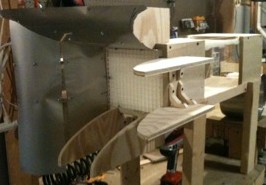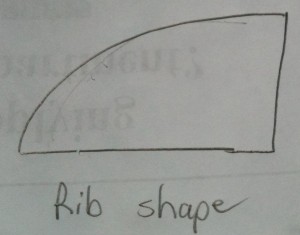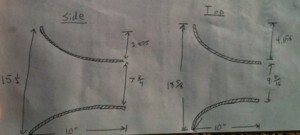Dear Fellows of the Basement Science Research Consortium,
For those new to the field, it is an important lesson to learn that the longer and more complicated the organization name, the more prestigious and talented the group. Therefore, we are part of a very important research group!
Our next task is to build the bell mouth. An overview of this was explained here a little earlier. I was trying to think of a good way to construct this as I was wandering though Home Depot. First, I browsed the ducting aisle with no luck, but came across aluminum flashing in the insulation section. I thought this would do very well. It is in long sheets, very bendable, and yet stiff. This will serve as the surface of the bell mouth, but we need to build a structure to hold it in place. It does not need to be a solid surface, but just a rib structure to attach the flashing. So, my idea was to use correctly shaped rips attached to the test section with gusset. The flashing could then be cut and the strips screwed to these ribs. Here is a picture previewing construction so you can get an idea of what was in my head:

With this idea we need to determine the shape of the bell mouth. Well, the secret is out because of the picture, but here was my process. The goal is to have as provide a smooth transition for air from the room into the test section. My first thought was a cubic polynomial which is just like a big nozzle. This is because I had just finished designing some nozzle for university research. After trying to draw some possible shapes, my ideas moved to a bell shape which made more sense, hence why I call it a bell mouth. The cubic nozzle provides a transition from its larger diameter to its smaller, while a bell mouth provides a transition from a theoretically infinite diameter to the test section. This is better. This design also alines with my experience in fluid mechanics lab. Here I performed tests with a water tunnel, like a wind tunnel, which used a bell mouth shape to funnel water from a reservoir. This is comparable to our situation, where the open basement is a reservoir and it moves into the wind tunnel.

So we have our shape but we need to choose the size. I want it to be big, but not bigger than I can manage constructing. The reason bigger is better is so the flow can more steadily, not abruptly, increase its speed. This promotes less turbulence in the test section. I decided, somewhat arbitrarily, to make the entrance twice the size as the test section. Since my test section is not square, the right and left will be a little larger than the top and bottom.
Here is the design overview of the bell mouth using my dimensions:


Okay, we have the design figured out and purchased the aluminum flashing, so its time to build. Its always exciting for me to start building because I get antsy if I spend a lot of time designing. It feels like I am not getting anything done, but in the end it saves so much time. It also feels really good to cut things.
Best Regards,
Ben Washington
Hi, you have an interesting site for folks like me who are curious about how and why things work, which leads me to ask about the bell mouth nozzle. Is the noise level of the flowing air reduced using a bell mouth? Reason I ask is I asked a friend to build me a shroud for an attic fan. It will sit sit over the top of the fan and act more as an exhaust tube to direct the air straight up to the ridge. The fan will sit 19 inches deep in this shroud. The shroud diameter is 27 inches and will shrink down to 24 inches at the top, like a bell shape. The fan itself is 27 inches as well. It will move at a rate of 3600 CFM. I am wondering how this will impact the db level of the fan compared to not having a shroud. If I mounted the fan above the shroud, which would then act as a bell mouth (so to speak), how do you think that would affect the db level? Just curious since I read about folks complaining about attic fan noise while standing on the ground with the fan mounted in the ceiling above them.
Darwyn,
Thanks for the interesting question! Actually, that might increase the noise! If I am understanding the design correctly, that would seem to act like a horn. The reasons horns make a voice, or other sound source, louder is it not only directs the sound but decreases the resistance of the sound waves moving from the source to the surrounding air. This is called impedance if you are interested. So the shroud you are discussing sounds like it might increases air flow, but there is a chance it may increase the noise too!
I would love to hear how the project went if you get the chance.
Best Regards,
Ben
Hi Ben,
I am currently busy with my dissertation and part if it revolves around the bellmouth and its design thereof. I read above that you were involved with the fluid mechanics labs and have experience with the bellmouth.
Could you please refer me to some sources where I can find the optimal design for a bellmouth that will discharge water?
Thanks again and all the best with your project,
Craig
Craig,
Thanks for your post and question. I actually don’t know. My design for this wind tunnel just came from my experiences and best guess. I did not consult any text books or references for the exact best shapes. If you are actually building an expensive test facility it is very important to find optimal designs and so forth, but this is basement science and pretty good is good enough. I think research follows the 80/20 rule: the first 80% of ideal takes 20% of the time, while the final 20% of ideal takes 80% of the time. Therefore, here we are just shooting for that first 80%, at only 20% of the time required.
If you need references, I would go to your engineering library. My guess is that there were some papers published on this topic in the 40’s and 50’s and some references probably came out after that. It seems to me a lot of fluids and aerodynamic stuff was done then.
Best Regards,
Ben